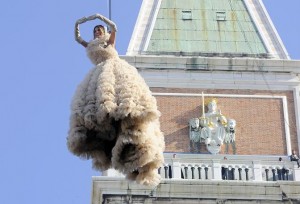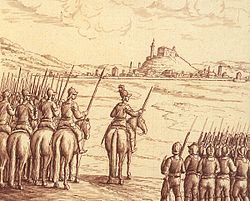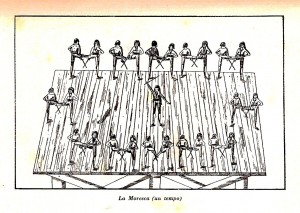At the begining of each Carnival is set the date for the start of the official celebrations.( Shrove Thursday )
 That begins on the first Saturday before Shrove Thursday and ends at Shrove Tuesday for a total of only eleven days.During the Carnival the business and affairs of the Venetians passed into the background, and they conceded every day of their time to the festivities, jokes, entertainment and events that were set up throughout the city, especially in Piazza San Marco ,along the Riva degli Schiavoni, in all the major “fields” of Venice.
That begins on the first Saturday before Shrove Thursday and ends at Shrove Tuesday for a total of only eleven days.During the Carnival the business and affairs of the Venetians passed into the background, and they conceded every day of their time to the festivities, jokes, entertainment and events that were set up throughout the city, especially in Piazza San Marco ,along the Riva degli Schiavoni, in all the major “fields” of Venice.
Ancient,…and strange …origin of the festival celebrate a major victory of the Venetian Republic against the Patriarch of Udine , Ulrich,(or Volrico or Vodolrico, which was nominated by Frederick Barbarossa in 1161)
synod of bishops to confirm the supremacy of Popone, the Cardinal of Aquileia against the patriarchy of Grade city ,a region, where Venice and Bisanzio had many interests .On 1028 the same Emperor gives to the Patriarch of Aquileia,Popone,a part of Friuli region.
In 1162 Ulrich,an other patriarch of Aquileia with some feudal vassals (to renew the  exploits of his ancestor), taking advantage of the ongoing war between Venice and the city of Padua and Ferrara, aided by the feudal lords of Carinthia and Friuli, attacked the town of Grado, forcing the patriarch Enrico Dandolo to take refuge in Venezia.The patriarch Dandolo with military aid from the Doge Vitale Michieli II defeats the enemy, regaining the city, and captures the Ulrich with twelve of his canonicals, and leads them ,in triumph, to Venice.
exploits of his ancestor), taking advantage of the ongoing war between Venice and the city of Padua and Ferrara, aided by the feudal lords of Carinthia and Friuli, attacked the town of Grado, forcing the patriarch Enrico Dandolo to take refuge in Venezia.The patriarch Dandolo with military aid from the Doge Vitale Michieli II defeats the enemy, regaining the city, and captures the Ulrich with twelve of his canonicals, and leads them ,in triumph, to Venice.
To break free from the prison they had to promise to pay an annual tribute to the Venetians:twelve loaves of bread, twelve pigs and a bull . The animals were then greeted as prisoners in the Ducal Palace. From that day, the ” Shrove Thursday “, the anniversary of the victory , the pigs and the bull who came to Venice were sentenced to death by beheading in a real process and the judgment was publicly performed in St. Mark’s Square . The meat of the “criminals” were then distributed among the senators of the Republic, while the loaves were distributed in the prisons.
 This honor was given to the guild of blacksmiths , assisted by that of the butchers ( Becheri ) ,who slaughtered the pigs and offered the meat to all the Venetian people.
This honor was given to the guild of blacksmiths , assisted by that of the butchers ( Becheri ) ,who slaughtered the pigs and offered the meat to all the Venetian people.
The Venetian said :” To cut the bull’s head ” (which means getting rid of the obstacles, ending up problem in a definitive way), because with the cut of the bull’s head was placed the end of the show ,comes from here .
The intention of the Doge , was to perpetuate the memory of the victorious warlike deeds ,as well as a warning to the enemies , to inspire the pride of the Venetian force to the future generations; because it was clear that the obligation of the offer was not intended to Grado city but to Venice
The Doge and the main representatives of the State , were protagonists of another singular ceremony : in a hall of the ducal palace were put on,the little wood models of castles in change of the originals of the feudal lords of Ulrich ,and armed with maces enjoyed smashing everything … an eternal reminder of the victory inflicted to Friuli
region.
This story, however, has a bad impact to the people of Udine, in the Shrove Thursday of the year 1511 and was called:
Cruel Shrove Tuesday.
 The Venetian government had never considered Friuli region at the same rank as the other domains but had interest to keep its dominance to keep as far as they can from Venice the Turkish and the (holy Roman) imperial army .
The Venetian government had never considered Friuli region at the same rank as the other domains but had interest to keep its dominance to keep as far as they can from Venice the Turkish and the (holy Roman) imperial army .
This attitude is also reflected in the policy characterized by the lack of measures to improve the condition of the population ( mainly rural ) on the social and economic development. The nobility , deprived of its ancient power by the government of Venice , tried to maintain his social status by exploiting the few remaining rights and the services owed by farmers bringing to exasperation the feudal relations between subordinate ( farmer ) – sir (noble ) .Because of that the farmers gathered in ( a kind of party) of Zamberlani (çambarlans); the nobles also formed the party called the STRUMIERI
The day of ” Shrove Thursday “( February 27, 1511 ) Antonio Savorgnan , (the general commandant of the “cernide”,the armed militias of farmers who were called up in the case of war) staged an “Imperial” attack against Udine (actually ” the imperial army” was soldiers commanded by Alvise da Porto , his nephew ) . In the midst of the chaos created by the failure of the attack, the Savorgnans capitans stirred up the armed population , to the looting of the dwellings of the cities (lands of the noble family called “della Torre” )
which followed in the wake of lust booty, those of all the nobility of Udine (except for the palace of the Savorgnans,the true head of the revolt ) .
Meanwhile, in the wake of the violence spread like wildfire to the territories of Udine and
 slowly throughout all the region. The villagers , mostly farmers , armed as to go into battle besieged the nearby castles inhabited by the nobility .
slowly throughout all the region. The villagers , mostly farmers , armed as to go into battle besieged the nearby castles inhabited by the nobility .
The Venetian government set up a special tribunal that condemned to death the major leaders of the revolt ,without hitting the real architect , Antonio Savorgnans .
Revenge , however, is not long late because “the strumieri” organized a conspiracy to murder him.That occurred on March 27, 1512 at the exit of the cathedral of Villach ,being killed by two Udinese nobles.
The tradition of the bulls and pigs continued until 1420 (the end of the temporal power of the patriarchs of Aquileia,when the Friuli region came under the domination of Venice), but despite the fact that the tribute was no more paid, the state continued to provide pigs and bulls for popular fun with the money from the Republic’s Treasury .That “playful tribute” gives rise to the much curious folk festivals.After the execution of the animals the celebrations followed which the “forces of Hercules”, stunts such as ” the turkish fly” and
dances such as the “Moorish” (warrior dance),the theme of the future articles.
other items:http://dipoco.altervista.org/articles/
visit my website http://ginocosta.altervista.org/
On facebook https://www.facebook.com/venice.venezia.5
